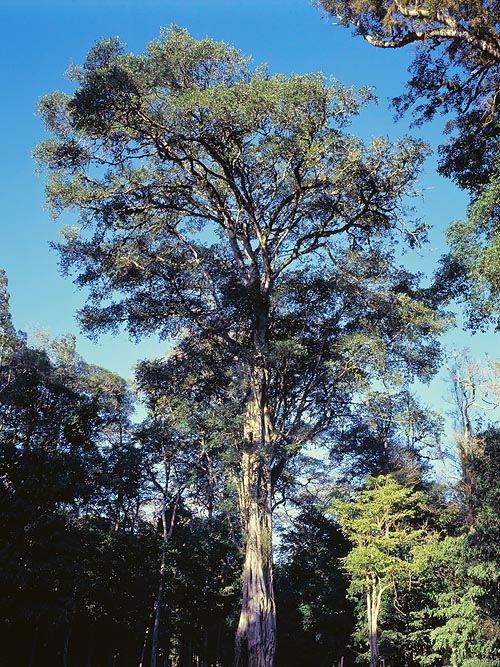Family : Oleaceae

Text © Pietro Puccio

English translation by Mario Beltramini

An Olea capensis subsp. macrocarpa in its habitat © Giuseppe Mazza
The name of the genus is the Latin name of the common olive (Olea europaea); the Latin name of the species, “capensis” = of the Cape, refers to one of its origin places, the name of the subspecies is the combination of the Greek terms “makrόs” = large and “karpόs” = fruit, with obvious reference.
Common names: East African olive, ironwood, mountain olive, olivewood (English); olivier d’Afrique (French); oliveira africana (Portuguese); loliondo (Swahili); Ostafrikanisches Olivenholz (German).
The Olea capensis subsp. macrocarpa (C. H. Wright) I. Verd. (1909) is a tree tall up to about 20 m, even if specimens in the wild may reach the 40 m, with greyish, longitudinally fissured, bark.
The leaves, on a 0,8-1,5 cm long petiole, are opposite, entire, coriaceous, oblong or elliptic, 4-10 cm long and 2-4 cm broad, with pointed apex, of glossy dark green colour on the upper page, paler green below with prominent central nervation.
The inflorescences are panicle terminal and at the axil of the last two pairs of leaves, 3,5-10 cm long, with scented flowers with campanulate calyx, 1 mm long, and 4 mm long corolla, white, with 4 ovate lobes.
The fruits are ellipsoid, about 2 cm long, drupes. It reproduces by seed with much variable germination times, going from some months to more than one year.
The species furnishes an excellent wood, of yellowish brown colour with irregular grey, brown and blackish veins, particularly hard and with fine-grained, utilized in the constructions in general, for furniture, boats, car parts, tools, stakes, handicrafts, etc., due to its high resistance to the abrasion it is often utilized for floors subject to high passage, excellent also as firewood and for producing charcoal. Parts of the plant, the leaves in particular, are various used in the traditional medicine for various pathologies.
Synonyms: Linociera urophylla Gilg (1901); Olea hochstetteri Baker (1902); Olea macrocarpa C.H.Wright (1909); Olea urophylla (Gilg) Gilg & G.Schellenb. (1913); Steganthus urophyllus (Gilg) Knobl. (1934); Olea guineensis Hutch. & C.A.Sm. (1937); Olea madagascariensis Boivin ex H. Perrier (1950); Olea perrieri A.Chev. ex H. Perrier (1950).
→ To appreciate the biodiversity within OLEACEAE family please click here.
